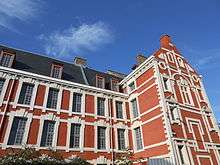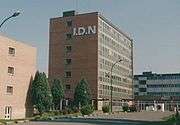École centrale de Lille
| Type | Public, Graduate engineering |
|---|---|
| Established | 1854-1872 |
| Students | 1300 |
| Location |
Villeneuve-d'Ascq, France 50°36′23″N 3°8′11″E / 50.60639°N 3.13639°E |
| Research labs | 7 |
| Affiliations |
Centrale Graduate School Université Lille Nord de France ASTech aerospace cluster I-Trans railways cluster |
| Website | http://www.ec-lille.fr |

Located in the campus of Lille University of Science and Technology in France, École Centrale de Lille is a renowned Graduate Engineering school, with roots back to 1854 as the École des arts industriels et des mines de Lille, re-organised in 1872 as Institut industriel du Nord. It is one of the Centrale Graduate Schools.
Its different curricula lead to the following French & European degrees :
- Ingénieur Centralien de Lille (Centralien Graduate engineer Masters level program)
- Masters Recherche & Doctorat (PhD doctorate studies )
- Mastères Spécialisés (MS) (Specialized Masters)
- Massive open online course in project management.[1]
Academic activities and industrial applied research are performed mainly in French and English languages. Students from a dozen of nationalities participate to the different curricula at École Centrale de Lille.
Most of the 1300 graduate engineer students at École Centrale de Lille live in dedicated residential buildings[2] nearby research labs and metro public transports on a campus that is shared with 20,000 students from Lille University of Science and Technology.
History
École Centrale de Lille was founded as École des arts industriels et des mines de Lille in 1854, the same year when Louis Pasteur became the dean of Faculté des sciences de Lille and pioneered applied research with industry cooperations, with support of scientists such as Charles Frédéric Kuhlmann. Between 1854 and 1871, students attending the two-year curriculum grew to 90 per annum. Baccalaureate was a prerequisite to admission to the engineering school.
|
In 1872 lectures and research activities in the engineering school were reorganised into a three-year curriculum and developed within its Institut industriel du Nord, with a focus on civil engineering, mechanical engineering, chemistry and manufacturing engineering. Electrical engineering full courses were added in 1892, automobile design has been taught from 1899 onwards. More than 200 students graduated in year 1914. Aerodynamics studies started in 1930. A stress on automatic control and computers was initiated in 1957. Later came courses and research in computer science, supply chain management, materials science, micro-electronics and telecommunications.[3]
Since early 20th century, student admission has been based on a competitive exam after attending a classe préparatoire aux grandes écoles or similar undergraduate studies.
École Centrale de Lille was originally located in Lille central district from 1854 to 1875. Larger buildings with dedicated laboratories were inaugurated in 1875 nearby the Faculté des sciences de Lille. It then moved in 1968 in the modern campus of Lille University of Science and Technology, in the south-east suburb of Lille.
Admission

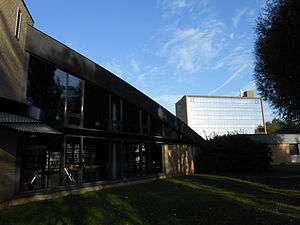

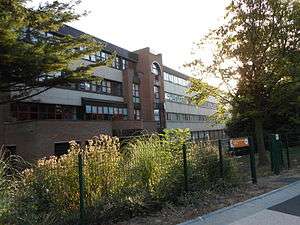
Admission to the Centralien engineering Programme[4] implemented at École Centrale de Lille is possible after two/three year scientific undergraduate studies and requires success to either:
- an admission exam for the Bachelor of Science degree : CASTing - Concours d'Admission sur Titre Ingénieur[5] (2-year curriculum)
- a French nationwide selective exam with numerus clausus : concours Centrale-Supelec[6] (3-year curriculum including at least 2 years in France)
- a selective application as per TIME double degrees[7] procedures applicable in Europe (2+2-year curriculum, including 2 years in France)
- a selective application as per TIME Overseas double degree procedures applicable for selected Universities and Institutes of Technology [8] in Brasil, Canada, Chile, China, Indonesia, Japan, Korea (2+2-year curriculum, including 2 years in France)
- a selective application as per IMCC procedure for one-semester or one-year accredited post-graduate study period in France and USA (1 year curriculum)
- a specific application process [9] for other international students[10] presented by their originating University.
The Centralien Programme typically lasts three years and results in a master's degree, augmented with international experience. Thus undergraduate studies + the Centralien Programme account for more than a cumulated 300 ECTS credit in the European education system.
However, graduate students enrolled in the TIME double degree procedure are required to spend two-years at École Centrale de Lille and spend two years in the TIME-partner institute[11] for a total of four years resulting in a double master's degree.[12]
Not to mention that 18% students attending courses at École Centrale de Lille are international students, all students enrolled in the Centralien Programme have an international exposure with opportunities to perform industry training and internship in enterprises worldwide, study abroad for 1 year in selected partner institutes providing Master (M2) courses, or be part of the 2+2 year TIME double degree programme.
In addition to the Centralien Programme, École Centrale de Lille provides a range of master's degree cursus in science and engineering that are opened to applicants who have completed their undergraduate studies in other institutes. Admission to Masters' second-year research cursus (M2R) is also possible for applicants who have performed their Master's first year (M1) in another institute and wish to focus on a research topic associated to Centrale Lille research labs.
Admission to one of the 6 Masters[13] (M1+M2 or M2) from École Centrale de Lille is possible upon an application assessment process based on academic criteria. Note that Masters/Research (M2R) workload is 60 ECTS credits and may be the starting point for doctorate studies. These 6 Masters and a larger number of Masters (M2) from other Centrale Graduate Schools and from partner institutes are also possible as electives for a double degree[14] alongside the Centralien Programme.
Admission to one of the 6 Specialized Masters for Master-level specialization and continuing education in specific engineering and management fields is possible upon application assessment based on candidate profile. Prerequisite to apply for this specialized curriculum is to already hold a Master or an equivalent postgraduate degree in a different scientific field. MS lectures at École Centrale de Lille are taught in English [15] and/or in French.[16] MS workload is 75 ECTS credits.
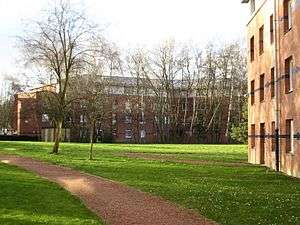
Research at École Centrale de Lille
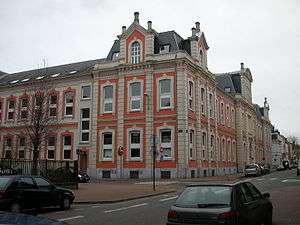
École Centrale de Lille is a member of the European Doctoral College Lille Nord de France[17] that provides 400 doctorate dissertations every year. École Centrale de Lille delivers the Doctorate degree in 7 Engineering Sciences specialities.[18]
PhD doctorate candidates shall preferably hold a Master of Sciences/Research degree prior to entering doctoral cursus. Academic doctoral research studies and industry-sponsored doctoral research studies can be performed in École Centrale de Lille research labs.
PhD doctorate candidates and visiting researchers are welcome and should contact directly one of the 7 research labs[19] associated to École Centrale de Lille.
- Automatic Control, Computer Science and Signal Processing : Laboratoire d'Automatique, Génie Informatique et Signal[20]
- Mechanical engineering, fluid mechanics & civil engineering : Laboratoire de mécanique de Lille[21]
- Electrical Engineering and Power Electronics: Laboratoire d'électrotechnique et d'électronique de puissance de Lille[22]
- Electronics, Microelectronics, Nano-technologies :Institut d'électronique de microélectronique et de nanotechnologie[23]
- Chemical engineering, Catalysis and Solid Chemistry: Unité de catalyse et de chimie du solide de Lille[24]
- Systems Engineering & Manufacturing : Laboratoire de génie industriel de Lille[25]
- Materials Science & Processing : Research unit[26]
Alumni
Association des Centraliens de Lille (alumni association)[27] supports École centrale de Lille and its graduates, organises conferences, events and funding campaigns for the Foundation Centrale-Initiative.[28]
- Louis Dollo (1877), paleontologist known for his work on Iguanodons and paleobiology (Dollo's law of irreversibility)
 Jacques Vandier (1895), inventor of automobile brakes and clutches, owner of Valeo automotive supplier
Jacques Vandier (1895), inventor of automobile brakes and clutches, owner of Valeo automotive supplier Eugène Lefebvre (1898), test pilot and world's first pilot to be killed in an accident while flying an engine aircraft
Eugène Lefebvre (1898), test pilot and world's first pilot to be killed in an accident while flying an engine aircraft Etienne Dormoy (1906), known as the designer of the first certified aircraft (US type approval n°1 - 1927)
Etienne Dormoy (1906), known as the designer of the first certified aircraft (US type approval n°1 - 1927)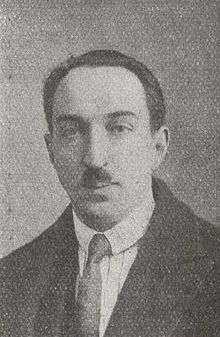 Jean Hubert (1906), aircraft chief engineer, world record aircraft crossing of the North Atlantic ocean
Jean Hubert (1906), aircraft chief engineer, world record aircraft crossing of the North Atlantic ocean Pierre Picavet (1912), inventor of the Picavet suspension for aerial photography
Pierre Picavet (1912), inventor of the Picavet suspension for aerial photography Lucien Chenard (1920), CEO of Chenard et Walcker car manufacturer
Lucien Chenard (1920), CEO of Chenard et Walcker car manufacturer Pierre Bataille (1946) and Jacques Bataille (1944), inventors of Poclain hydraulic excavators
Pierre Bataille (1946) and Jacques Bataille (1944), inventors of Poclain hydraulic excavators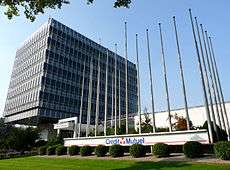 Bank information technologies pioneered and developed by Michel Lucas (1965), président of Crédit Mutuel
Bank information technologies pioneered and developed by Michel Lucas (1965), président of Crédit Mutuel Robert Castaigne (1968), CFO and board member of Total petroleum company
Robert Castaigne (1968), CFO and board member of Total petroleum company Marc-Philippe Daubresse (1976), French politician and government minister
Marc-Philippe Daubresse (1976), French politician and government minister Hubert Sagnières (1980), CEO Essilor, manufacturer of ophthalmic optical equipment
Hubert Sagnières (1980), CEO Essilor, manufacturer of ophthalmic optical equipment
Notable faculty
- Claude Auguste Lamy, chemist, faculty member from 1854 to 1865, known for his discovery of the chemical element thallium in 1862
- Joseph Valentin Boussinesq, mathematician and physicist, faculty member from 1872 to 1886, known for Boussinesq approximation in continuum mechanics
- Victor Henry, linguist, faculty member from 1872 to 1883
- Alfred Mathieu Giard, bio-engineering physicist, faculty member from 1872 to 1882
- Bernard Brunhes, physicist, taught electrical engineering until 1885, known for his discovery of geomagnetic reversal
- Gaston du Bousquet, taught steam locomotive engineering until 1894
- Camille Matignon, thermo-chemist, faculty member from 1894 to 1898
- Henri Padé, mathematician, faculty member from 1897 to 1902, known for Padé table and Padé approximant
- Albert Châtelet, scientist known for Châtelet algebraic variety, faculty member from 1913 to 1921, and politician, candidate for French presidential election, 1958
- Joseph Kampé de Fériet, taught fluid dynamics and information theory from 1930 to 1969.
École Centrale de Lille as a hub for engineering science
- International role for engineering pedagogy, academic programmes and double degrees, including :
- Centrale Graduate School with Centralien programme and third-year student mobility;
- Top Industrial Managers for Europe (TIME) double degrees network implemented in Europe and worldwide.
- Focal role in Lille Eurodistrict for a pole of excellence with engineering programmes and double degrees with the following specialized institutes located in the neighbourhood of École Centrale de Lille:
- Université des Sciences et Technologies de Lille (USTL) for joint Masters curricula[29] and research labs in engineering science;[30]
- École nationale supérieure de chimie de Lille with joint chemical engineering research laboratory, associated to a Masters'degree in Catalysis and Processes, to a Mastère (MS) Spécialisé in Drug design and to a Mastère (MS) Spécialisé in Intellectual Property;
- ESC Lille Graduate School of Management joint programme in Entrepreneurship ;
- ESA - École Supérieure des Affaires de Lille in a Banking & Finance advanced programme;[31]
- Faculté polytechnique de Mons for MSc in architectural engineering.[32]
- Focal role in Europe for doctoral studies and research labs in engineering domains organised as
- European Doctoral College Lille Nord de France [33] and its Doctoral school of engineering science[34]
- Centrale Lille research labs grouping researchers in Lille and hosting laboratories shared with other institutes
- Member of CARNOT ARTS research institute[35]
- Joint research activities with
- CARNOT C3S,[36]
- CARNOT IEMN (Institut d’Electronique, de Microélectronique et de Nanotechnologie) research institute,[37]
- CARNOT INRETS - IFSTTAR (French institute of science and technology for transport, development and networks),[38]
- CARNOT ONERA (fluid mechanics) Institut de mécanique des fluides de Lille[39]
- Joint researches in computer science with Laboratoire d'Informatique Fondamentale de Lille and with INRIA Lille Nord Europe [40]
- Joint researches in intelligent transportation systems through GRRT research cluster.[41]
References
- ↑ (French)MOOC Gestion de projet
- ↑ "404". Retrieved 21 July 2015.
- ↑ "Histoire". Retrieved 21 July 2015.
- ↑ "The trainings". Retrieved 21 July 2015.
- ↑ CASTing - Concours d'Admission sur Titre Ingénieur
- ↑ "Centrale-Supélec Bienvenue". Retrieved 21 July 2015.
- ↑ "T.I.M.E. - Top Industrial Managers for Europe". Retrieved 21 July 2015.
- ↑ "404". Retrieved 21 July 2015.
- ↑ "The Ecole Centrale de Lille's international politic". Retrieved 21 July 2015.
- ↑ "Accueil > CampusFrance". Retrieved 21 July 2015.
- ↑ "T.I.M.E. - Top Industrial Managers for Europe". Retrieved 21 July 2015.
- ↑ TIME double degree example : Graduate Engineer & Architect double degree requires two initial years at École Centrale de Lille to attend the core Centralien Programme and select appropriate electives related to architecture, then third and fourth years cursus is related to both Centrale Lille and the TIME partner institute's cursus in Architecture. The students then get both the Centralien Graduate engineer Master's degree and a Master's degree in Architecture from the partner institute, with a capability to work both as an engineer and an architect, in whole Europe
- ↑ "The trainings". Retrieved 21 July 2015.
- ↑ Beyond Centrale Lille's own Masters degrees, students from the Centralien Programme may select among few Masters (M2) from partners institutes in Lille as an integrated elective part of their third year at École Centrale de Lille : elective Masters may be from scientific fields (Applied maths and others) or from other fields such as Banking & Finance. The third year of the Centralien programme may be also spent either in another Centrale Graduate School or abroad for one year in selected Master (M2) programmes from partner universities.
- ↑ "Continuing education". Retrieved 21 July 2015.
- ↑ "Formation continue". Retrieved 21 July 2015.
- ↑ "Les Ecoles Doctorales Lille Nord de France: Présentation du Collège Doctoral". Retrieved 21 July 2015.
- ↑ "The trainings". Retrieved 21 July 2015.
- ↑ "Laboratories". Retrieved 21 July 2015.
- ↑ LAGIS: LABORATOIRE D'AUTOMATIQUE, DE GENIE INFORMATIQUE ET SIGNAL UMR CNRS 8146
- ↑ LML: LABORATOIRE DE MECANIQUE DE LILLE UMR CNRS 8107 - Member of CARNOT ARTS Institute
- ↑ "LABORATOIRE D'ELECTROTECHNIQUE ET D'ELECTRONIQUE DE PUISSANCE DE LILLE - Recherche, Développement et Innovation en Génie Electrique". Retrieved 21 July 2015.
- ↑ IEMN: INSTITUT D'ELECTRONIQUE, DE MICROELECTRONIQUE ET DE NANOTECHNOLOGIE UMR CNRS 8520 - CARNOT IEMN Institute
- ↑ UCCS: UNITE DE CATALYSE ET DE CHIMIE DU SOLIDE UMR CNRS 8181
- ↑ Master degree in Systems engineering - LGIL: LABORATOIRE DE GENIE INDUSTRIEL DE LILLE - (Centrale Graduate School -Laboratoire de Recherche en Génie Industriel) associated to CARNOT C3S Institute and in cooperation with European Doctoral College Lille Nord de France
- ↑ "École Centrale de Lille - Accueil". Retrieved 21 July 2015.
- ↑ Centraliens de Lille alumni association
- ↑ "History". Retrieved 21 July 2015.
- ↑ "Catalogue des formations de l'université de Lille 1 - Sciences et Technologies". Retrieved 21 July 2015.
- ↑ "ED SPI: Documents et textes règlementaires". Retrieved 21 July 2015.
- ↑ Banking & Finance advanced programme
- ↑ "Université de Mons". Retrieved 21 July 2015.
- ↑ "Les Ecoles Doctorales Lille Nord de France: Présentation du Collège Doctoral". Retrieved 21 July 2015.
- ↑ "ED SPI: Home". Retrieved 21 July 2015.
- ↑ CARNOT ARTS research institute in engineering sciences
- ↑ "Untitled Document". Retrieved 21 July 2015.
- ↑ "IEMN - Institut d'Electronique, de Microélectronique et de Nanotechnologie". Retrieved 21 July 2015.
- ↑ IFSTTAR- CARNOT INRETS (Institut National de Recherche sur les Transports et leur Sécurité) research institute on Intelligent Transport Systems in Villeneuve d'Ascq
- ↑ "ONERA - Le centre Onera de Lille". Retrieved 21 July 2015.
- ↑ INRIA Lille Nord Europe (Villeneuve d'Ascq) research in computer sciences
- ↑ "Laboratoires". Retrieved 21 July 2015.
External links
- Centrale Lille Graduate School: Centrale Lille web site
- Centrale Lille : library & documentation centre
- Centrale Lille students Portal
- Centrale Lille students union site
- Centrale Lille : new students integration site
- Top Industrial Managers for Europe (TIME network)
- (Wikimapia) Map of École centrale de Lille
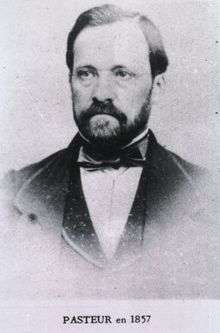

_1860.png)
